Mike Caruso Sr. was born March 4, 1899 in San Pedro, Italy. He came to the United States with his parents, the following year. When his father died 1912 he was forced to quit school and help support his mother. With only a sixth grade education behind him and a natural mechanical ability, Mike went to work in a Brooklyn auto garage and quickly became an excellent mechanic. Read the complete story HERE:
CARUSO RACING
The first auto mobile race Mike Caruso saw was one held at the Sheepshead Bay, Long Island board track in 1916. Although offered an opportunity to become a riding mechanic for one of the race car owners, he did not because his mother was against it.
The first “race car” Mike constructed was made from a world record motorcycle engine which was the first to exceed one hundred miles per hour and was mounted on a make-shift car. Although this car never actually competed in a auto race, it was a unique vehicle. With only his shoe heels for brakes, young Caruso and a friend, would drive to Coney Island and once tried to compete against police motorcycle racers who refused to compete with this four wheel vehicle.
In September 1922, Mike married Rose Adessio and moved from Brooklyn to Hicksville in 1923. The young mechanic started in business by operating an auto garage but soon found he could make a better living buying used cars and selling them, either as parts or as complete cars. In 1927 he founded his Hicksville Auto Wreckers.
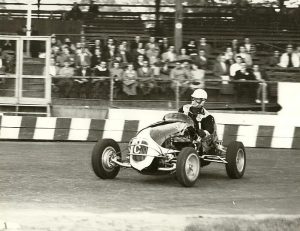
The first car Mike Caruso owned, which was exclusively for racing, was a sprint car he bought in 1927 from Harold Stillwell’s of Oyster Bay. This car was equipped with an Anstead engine. In 1929 he built his first race car, also a ‘sprint car’, with a Riley engine. Caruso instructed a second sprint car soon afterward and competed at various tracks in the New York area (River Head, L.I., Dear Park, L.I., Flemington, New Jersey).He raced these sprint cars until 1935 when he built his first midget race car. This 4 cylinder Bugatti ‘black #6’ midget racing car took only a month to built but won the 1935 Eastern Auto Racing Association Championship, with Johnny Duncan of Lawrence, New York, at the wheel.
This win launched Mike Caruso on a long course of highly successful race car competition in which his skill as a mechanic and designer led him to numerous championships. Throughout his career, Mike was a pioneer in automotive engineering. A very resourceful mechanic, he used his auto wrecking yard business in Hicksville as a ready source of parts needed in the development of powerful racing engines. At this time most racing engines prototypes, each engine being developed through modification of passenger car, motorcycle or outboard engines.
Caruso’s Hicksville Auto Wreckers was one of the largest ‘Junk Yards’ on Long Island in the ‘30’s and later became one of the most famous junk yards in the United States. His junk cars were obtained from the Gold Coast estate owners of North Shore and included one of the most expensive and coveted cars of all times: Isotta Fraschini, Rolls Royce, Pierce Arrow, Mercedes Benz, Alfa Romeo and many others. He owned at one time or another, seven of the most valuable cars in the world today, among them the Kaiser’s car.
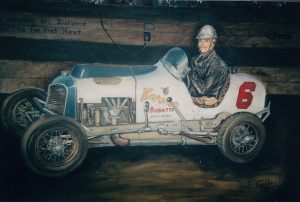 One of the numerous innovative designs Caruso is credited with was his transformation of the Bugatti T38 8 cylinder engine into a 4 cylinder engine which conformed with midget racing specifications. This was achieved in 1936 for a Caruso midget driven by Ernie Gessell. This same car won the 1937 National Auto Racing Circuit Championship, with Ernie Gessell winning 12 consecutive feature races at the Long Branch, New Jersey Speedway. It is not widely known, but Ronnie Householder, a leading driver racing one of the first Offenhauser engines in the East, offered to buy the Caruso Bugatti and never race it in the East- just to get it out of his hair.
One of the numerous innovative designs Caruso is credited with was his transformation of the Bugatti T38 8 cylinder engine into a 4 cylinder engine which conformed with midget racing specifications. This was achieved in 1936 for a Caruso midget driven by Ernie Gessell. This same car won the 1937 National Auto Racing Circuit Championship, with Ernie Gessell winning 12 consecutive feature races at the Long Branch, New Jersey Speedway. It is not widely known, but Ronnie Householder, a leading driver racing one of the first Offenhauser engines in the East, offered to buy the Caruso Bugatti and never race it in the East- just to get it out of his hair.
Mike Caruso achieved much success in auto racing through his association with the Offenhauser engine. The ‘Offy’ engine was more modern, double overhead cam engine which was very reliable due to the availability of engine parts. It must be understood that earlier racing engines were modified pleasure car engines, while the ‘Offy’ engine was designed and built strictly for racing.
The year 1938 was significant for Mike Caruso. This was the year he bought his first ‘Offy’ engine. He mounted it in a midget and won the 1938 AAA Midget Championship with a young Paul Russo driving the white Caruso #5. Russo went on to win much fame in both sprint cars and Indianapolis type cars.
After finishing 2nd in the point standings in both 1939 ad 1940, Mike added Henry Banks to his stable of drivers in 1941. Other drivers were Eddie Gessell and Bill Schindler. The latter was a hard charging driver who lost a leg in at race at Mineola, New York speedway in 1936. The addition of Henry Banks to his team was a good one for Caruso as he won the 1941 American Racing Driver Club (ARDC) Championship.
World War II shut down midget car racing for the duration of the hostilities in the interests of gasoline conservation. When racing was resumed in ’45, it picked up where it left off in terms of public interest. Midget car competition had been very popular during the pre-war years. With the war over and the racing ban lifted, capacity crowds were a common occurrence at all midget race tracks. Freeport, N.Y., Paterson, N.J. (Hinchcliffe Stadium), Thompson and West Haven, Connecticut, were just a few of the many Eastern tracks that were selling out regularly. The 1945 season was only 3 months long, but Bill Schindler was proclaimed the ARDC Champion in the Caruso Black Deuce (#2).
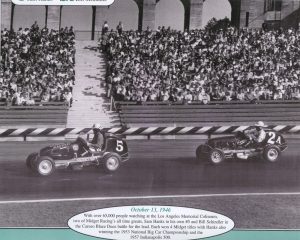 In 1946 the efforts of the Caruso racing team were intensified. The team, which now included Mike Caruso, his wife Rose, and his sons, Louis (Biff) and Mike, Jr., was now racing 8 times a week. This included 2 races each Sunday. Bill Schindler drove the Caruso Black Deuce in 1947 and 1948, and won the ARDC Championship in 1947and finished 2nd in 1948. It is interesting to point out that in 1947 and 1948, Schindler in the Caruso #2 won 53 main events each year out of a possible 106 starts. Schindler’s goal was to break 60 wins in a season, a feat the equivalent of Babe Ruth’s season record of 60 home runs. Although he never 60 wins, the dauntless Schindler record of 53 main events in each of two consecutive years is a milestone that probably will never be broken.
In 1946 the efforts of the Caruso racing team were intensified. The team, which now included Mike Caruso, his wife Rose, and his sons, Louis (Biff) and Mike, Jr., was now racing 8 times a week. This included 2 races each Sunday. Bill Schindler drove the Caruso Black Deuce in 1947 and 1948, and won the ARDC Championship in 1947and finished 2nd in 1948. It is interesting to point out that in 1947 and 1948, Schindler in the Caruso #2 won 53 main events each year out of a possible 106 starts. Schindler’s goal was to break 60 wins in a season, a feat the equivalent of Babe Ruth’s season record of 60 home runs. Although he never 60 wins, the dauntless Schindler record of 53 main events in each of two consecutive years is a milestone that probably will never be broken.
1948 was different from previous years in that the 53 wins involved other than just ARDC races. The Caruso team raced from coast to coast, wherever the best competition and the largest prize money could be found. It was also the year that Mike Nazaruk drove the second Caruso “Offy” – Black #3 to 38 main event feature wins. When one considers that Bill Schindler won 53 main events and Nazaruk won 38 main events, it is clear that 1948 was an incredibly successful season. Ninety-one wins out of one hundred and six total races is a win percentage of 86%. Fantastic!
Schindler had his sights set on the Indianapolis 500 as 1949 began but was required to drive six spring car races before he was permitted to take his Indianapolis rookie driver test. With his top driver available only part-time, Mike Caruso had to use other drivers as well.
Probably one of the most revolutionary innovations Caruso ever came up with occurred in 1950. The ingenious mechanic decided to “stretch” his #2 midget into a sprint car, the racing car-type intermediate between midget and Indianapolis race cars. This was a midget with a wheelbase lengthened and a regular 110 cubic inch “Offy” engine surpercharged with a 1923 Mercedes Benz racing car blower. This concept was strictly experimental – so new it literally shook the racing world from coast to coast.
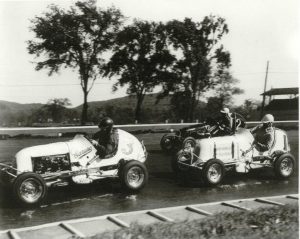 Probably one of the most revolutionary innovations Caruso ever came up with occurred in 1950. The ingenious mechanic decided to “stretch” his #2 midget into a sprint car, the racing car-type intermediate between midget and Indianapolis race cars. This was a midget with a wheelbase lengthened and a regular 110 cubic inch “Offy” engine surpercharged with a 1923 Mercedes Benz racing car blower. This concept was strictly experimental – so new it literally shook the racing world from coast to coast.
Probably one of the most revolutionary innovations Caruso ever came up with occurred in 1950. The ingenious mechanic decided to “stretch” his #2 midget into a sprint car, the racing car-type intermediate between midget and Indianapolis race cars. This was a midget with a wheelbase lengthened and a regular 110 cubic inch “Offy” engine surpercharged with a 1923 Mercedes Benz racing car blower. This concept was strictly experimental – so new it literally shook the racing world from coast to coast.
The revolutionary race car, with Mike Nazaruk driving finished 3rd in point standings. It won the second race it competed in, and won many more that season. 1950 was important, as well, for a distinct honor for the Caruso team with Mike Nazaruk won two races in one day in two types of cars: a sprint car win at Williams Grove Speedway, Pennsylvania in the afternoon followed by a midget car race win that night at Hatfield, Pennsylvania!
Nazaruk, like Schindler, had his eyes on Indianapolis, and by driving the sprint car achieved the practice and technique necessary to qualify as an Indy driver. In 1951, as a rookie at the Indianpolis 500, Mike Nazaruk finished 2nd to Lee Wallard. With Nazaruk driving only the first part of the 1951 season for the Caruso team, Mike Caruso employed many top drivers that season. They included: Duke Nalon, Dutch Schaefer, Bobby Barker, Ernie McCoy, Len Duncan and Gays Biro, as well as others. These drivers won many races for the Caruso team.
In 1952 Mike got Paul Russo to drive the sprint car. Russo won numerous races while traveling throughout the country. Duke Nalon also drove successfully that year.
The last year of intensive competition was 1953 with Johnny Thomson at the wheel of the sprint car. He triumphed in many feature races, and is considered by some race authorities to be one of the all-time great drivers.
After 1953, the Caruso racing effort was scaled down as a result of Mike’s other business activities. The wrecking yard, as well as a Gulf gas station, took quite a bit of Mike’s time. In the years that followed, racing was undertaken more for the enjoyment of it, rather than as a seven day a week business.
Probably the best driver of the years 1954-1957 was Russ Klar of Lynbrook, New York. He took many races for the Caruso team, most notably a 200 lap race at Freeport Stadium in 1956, a race which required a thirty second pit stop to change two tires as part of the qualification.
After 1953, the Caruso racing effort was scaled down as a result of Mike’s other business activities. The wrecking yard, as well as a Gulf gas station, took quite a bit of Mike’s time. In the years that followed, racing was undertaken more for the enjoyment of it, rather than as a seven day a week business.
Probably the best driver of the years 1954-1957 was Russ Klar of Lynbrook, New York. He took many races for the Caruso team, most notably a 200 lap race at Freeport Stadium in 1956, a race which required a thirty second pit stop to change two tires as part of the qualification.
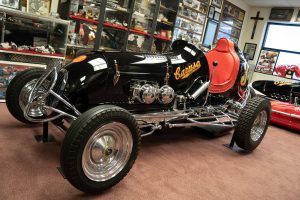 Mike Caruso, still the innovator, kept his hand in racing until the ‘70’s. It was now a hobby for him, and he experimented quite a bit. He ran sprint cars in the ‘60’s and in 1965, ’66 and ’67 helped his son, Louis (Biff) Caruso at Indianapolis, on cars wherever his son was chief mechanic. In the late ‘60’s and early ‘70’s he toyed with a Chevy II engine in a midget race car.
Mike Caruso, still the innovator, kept his hand in racing until the ‘70’s. It was now a hobby for him, and he experimented quite a bit. He ran sprint cars in the ‘60’s and in 1965, ’66 and ’67 helped his son, Louis (Biff) Caruso at Indianapolis, on cars wherever his son was chief mechanic. In the late ‘60’s and early ‘70’s he toyed with a Chevy II engine in a midget race car.
1978 brought distinction to Mike Caruso. He was elected to membership in the eastern Old Timers Auto Racing Club ‘Hall of Fame’ at Flemington, New Jersey. This honor was a tribute to his many contributions and years of hard work on behalf of the sport of auto racing. Mike was the first car owner elected to the ‘Hall of Fame’. On May 5, 1982 he was read into the Congressional Records for his achievement’s in auto racing. In 2003 he was inducted into the National Midget Hall of Fame located in Sun Prairie, Wisconsin.
Mike and Rose Caruso were the parents of five children: Rose, Frances, Florence, Louis and Michael, Jr. He spent most of his final years between Hicksville, New York and Las Vegas, Nevada, where he owned a residence. Mike died on February 9, 1982, at 82 years of age and Rose died July 17, 1988 at age 84.
